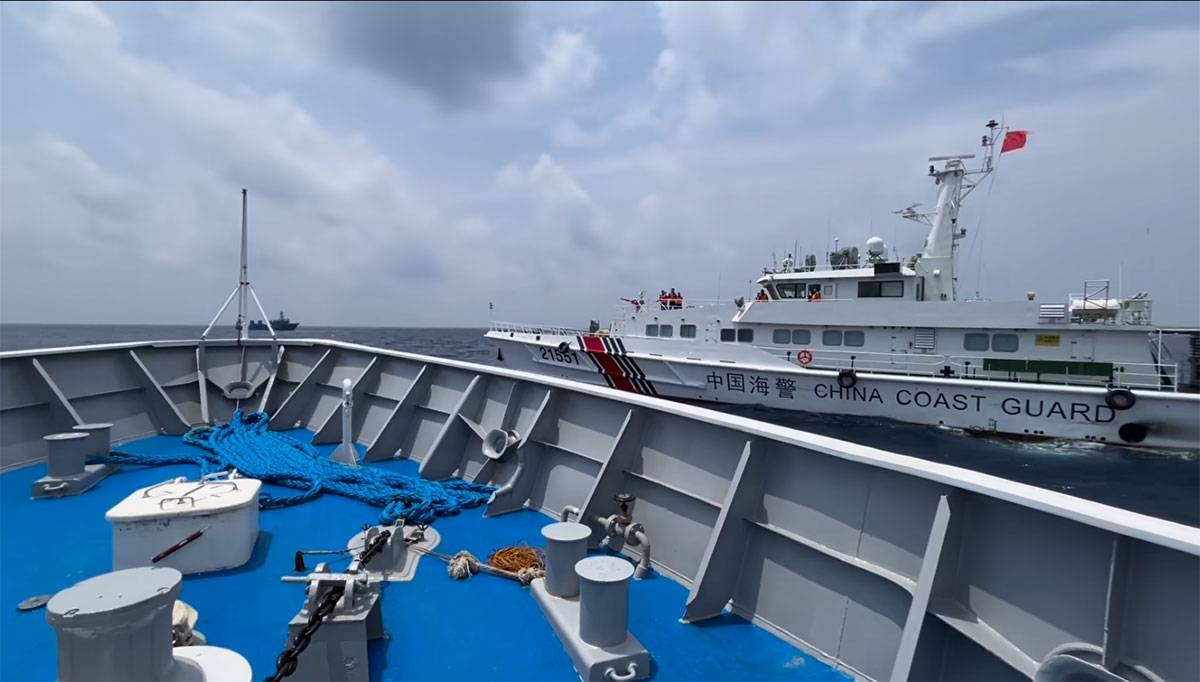ABOARD BRP SINDANGAN: A Chinese coast guard ship came within 3 feet of colliding with a Philippine patrol ship it was trying to block in the South China Sea, in an alarming incident that intensified fears that territorial disputes in the waters could spark a larger crisis.
The Philippines on Friday strongly condemned the Chinese ship’s maneuvers near Second Thomas Shoal or Ayungin Shoal, which the Asian neighbors both claim and have been the scene of frequent confrontations.
One other Philippine Coast Guard (PCG) vessel was blocked and surrounded by Chinese coast guard and militia ships in the incident, which dragged on for about eight hours on Wednesday.
A major clash in the disputed waters could potentially involve the United States, which has vowed to defend the Philippines, its treaty ally, if Filipino forces, ships and aircraft come under armed attack.
Two smaller supply boats being escorted by the Philippine Coast Guard in the contested waters managed to breach the Chinese blockade and deliver food and other supplies to a Philippine Marine outpost at the shoal.
delivered to your inbox
“We condemn the behavior of the Chinese coast guard vessel. They have been violating international law, particularly the collision regulations,” PCG spokesman Commo. Jay Tarriela said at a briefing Friday.
A collision was averted when one of the two Philippine Coast Guard vessels, the BRP Sindangan, rapidly reversed its engine to avoid slamming into the Chinese coast guard ship that crossed its bow at a distance of only a meter, Tarriela said.
It’s “the closest dangerous maneuver” by any Chinese coast guard ship against a PCG, he said.
The incident was witnessed by several journalists, including from The Associated Press, who were invited by the PCG to join the voyage as part of a strategy aimed at exposing Chinese aggressive actions in the South China Sea.
A small contingent of Filipino marines and navy personnel has stood guard for years on a long-marooned but still commissioned warship, the BRP Sierra Madre, at the shoal.
China has surrounded it with its coast guard ships and militia vessels to prevent the Philippines from delivering construction materials that Beijing fears could be used to reinforce the Sierra Madre and turn it into a permanent territorial outpost.
Wednesday’s hostilities began at dawn when a Chinese coast guard ship closely tailed the Philippine vessels enroute to Second Thomas Shoal. A swarm of Chinese coast guard and militia ships, including at least one navy warship, later emerged and formed a blockade in the high seas off the shoal.
A Chinese coast guard radio operator asserted repeatedly to the BRP Sindangan that “China has indisputable sovereignty” over the Second Thomas Shoal and outlying waters. “To avoid miscalculations, leave and keep out,” the Chinese radio operator warned.
Filipino coast guard personnel responded by asserting Philippine rights to the area and saying they would proceed with the delivery of the supplies.
The Chinese coast guard said in a statement Wednesday night that the Philippine vessels entered the waters “without permission from the Chinese government” and that “China firmly opposes the Philippines illegally transporting building materials to the ‘grounded’ military boat.”
It said it gave a stern warning to the Philippine vessels and monitored them throughout the process.
It was the latest flare-up in long-simmering territorial disputes in the South China Sea, one of the world’s busiest trade routes.
The conflicts, which involve China, the Philippines, Vietnam, Malaysia, Taiwan and Brunei, are regarded as a potential flashpoint and have become a delicate fault line in the US-China rivalry in the region.
In early August, a Chinese coast guard ship used a water cannon against one of two Philippine supply boats to prevent it from approaching Ayungin Shoal.
The move, which was caught on video, outraged President Ferdinand Marcos Jr. and prompted the Department of Foreign Affairs (DFA) to summon the Chinese ambassador to convey a strongly worded protest.
Washington reacted by renewing a warning that it is obligated to defend the Philippines as a treaty ally.
The Chinese Foreign Ministry accused Washington of “threatening China” by raising the possibility of activating the US-Philippine Mutual Defense Treaty.
Beijing has repeatedly warned the US not to meddle in regional territorial disputes.
Later in August, the Philippines again deployed two boats, which succeeded in maneuvering past the Chinese coast guard blockade and completing the delivery of supplies to the Filipino forces at Ayungin.
Two PCG ships securing the supply boats, however, were prevented by Chinese coast guard ships from maneuvering closer to the shoal.
A US Navy surveillance aircraft flew in circles in support of the Philippine vessels as the standoff continued for more than three hours.
Defense Secretary Gilberto “Gibo” Teodoro Jr. expressed concern over dangerous Chinese actions at sea and said the government is ready to respond to potential emergencies, including any collision between Chinese and Philippine ships in the disputed waters.
“Naturally, the concern is always there, and we take that into account,” Teodoro said Tuesday night. “We have plans depending on what happens.”
A 2016 arbitration ruling set up under the 1982 UN Convention on the Law of the Sea (Unclos) invalidated Beijing’s claims on historical grounds to virtually the entire South China Sea.
China refused to participate in the arbitration sought by the Philippines, rejected the decision as a sham, and continues to defy it.
On Friday, a group of retired soldiers told Chinese President Xi Jinping to spare territories in disputed areas of the West Philippine Sea (WPS).
In a manifesto of protest, the Rebolusyong Alyansang Makabansa (RAM) made a “humble appeal” to Xi to “please spare our own occupied territories in the West Philippine Sea, albeit the present disputes ongoing with your country, our country, and other nations of the world.”
The group said, “The Filipino people will never allow anyone to trample the rights and territories of our Motherland. Our country is very small compared to your big country but we will stand firm, as what our heroes and martyrs have done against foreign colonizers of our lands the past hundreds of years.”
It clarified that Filipinos are not the Chinese people’s enemies, since they have shared historical bonds for hundreds of years.
With ARIC JOHN SY CUA

















